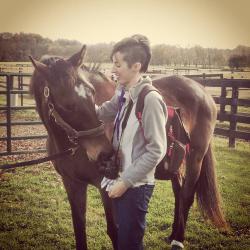
A heavy favorite, Dortmund was defeated in the BC Dirt Mile by Tamarkuz (photo by Dawna Wood).
Before the horses even entered the starting gate, there was some grief in the air and over social media about the existence of the Las Vegas Breeders’ Cup Dirt Mile (GI).
Drawing nine horses — seven of which were trying to win a Grade 1 for the first time — the Dirt Mile itself wasn’t a deeply competitive race. Last year’s Breeders’ Cup Sprint (GI) winner Runhappy took the lead early before ultimately flailing to an eighth-place finish in what was only his second start of the year. Heavily-favored Dortmund, who had campaigned strongly against some of the country’s best dirt horses at nine and ten furlongs this year, was out of gas before he turned for home and finished fourth.
The victorious Tamarkuz, who hadn’t won a race in over a year, had been prepped for the Dirt Mile with a runner-up finish to A.P. Indian in the “Win and You’re In” Breeders’ Cup Sprint qualifier, the Sentient Jets Forego Stakes (GI) at Saratoga Race Course. Second-place Gun Runner was cross-entered for the Breeders’ Cup Classic (GI), but ultimately went to the Dirt Mile because it was a winning distance for him. Accelerate, a 30-1 longshot who nosed out Dortmund for third, won the 9-furlong Los Alamitos Derby (GII) as well as the Shared Belief Stakes at a mile.
At 11-1, Tamarkuz surely made a few savvy handicappers happy, but valid questions lingered: Should Tamarkuz have gone to the Sprint instead, another poorly-filled race that went off with just eight horses? Should Dirt Mile runner-up Gun Runner, who had proven his mettle time and again at routes, have gone to the nine-horse Classic? And a question that was particularly glaring this year: Are Dirt Mile contenders just throwaways from the Classic and the Sprint races?
For a country that thrives on breeding and racing dirt horses, it’s mysterious to see the Dirt Mile fail, but not entirely surprising given the valuation of dirt horses at stud where classic types and fleet sprinters draw the most interest. The Breeders’ Cup Marathon, at 1 ¾ miles on dirt, was tossed out as an official race three years after being upgraded from Grade 3 status to Grade 2, but attracting few strong distance contenders on the main track. Also discontinued, the Juvenile Sprint on dirt lasted only two years after attracting few contenders, mainly lesser offshoots from the main two juvenile races.
As powerful and important as races like the Met Mile (GI) and the Cigar Mile (GI) are, they frequently attract top distance horses as well as sprinters in a fireworks display of who can carry their speed. Most dirt horses in America are pointed for the classic staying distance or brilliant displays of short speed in an effort to boost their value. However, to keep a horse’s value high, connections are pointing to races they have a better shot in, which, in turn, often hurts the main events. Liam’s Map, who had shown gusto at the classic distance after winning the Woodward Stakes (GI) last year, opted to win the Dirt Mile instead of challenging American Pharoah in the Classic.
The Breeders’ Cup World Championships consist of races that represent the best of each division clashing for top honors. The problem is that there is no dirt mile division in everyday racing, and there probably won’t be until a significant growth of participation in the sport.



